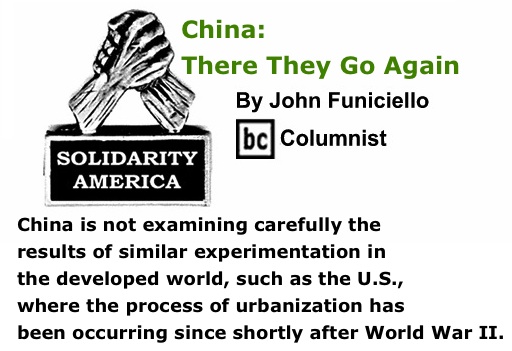




About
40 years ago, news reached the U.S. that Mao Zedong instructed his
people that he wanted Chinese agriculture to be more like that of the
West, that is, industrial agriculture.
It was a time in the U.S. that organic farming and gardening was just
beginning to take hold and those who were practitioners of the method
of growing food had just one question about the Great Leader: Is he
nuts?
The Peoples Republic of China was still a fairly insular society at
that time and the general American public did not read much about it in
the newspapers or see news programs about it on television, so Mao’s
wish was somewhat of a shock to those who were becoming alarmed about
the way Americans’ food was being grown, processed, and sold in
supermarkets.
The things that worried the Americans concerned about the quality of
their food were mostly the same things that worry them today: the
mechanization of farming and the gradual increase in the size of farms
which required giant machinery, the increasing heavy use of pesticides
and chemical fertilizers, depopulation of rural communities, the
control of the entire food system by a small number of corporations,
and, not least, the depletion of the soil through monoculture on
monumental acreages that has become the dominant form of agriculture in
America.
There were those in the U.S. who saw the
direction of the country’s agriculture and began working on ways to
change it to make it more sustainable. Those were the people who could
not understand the inclination of Mao to force his country into the
same kind of farming methods that were beginning to fray the edges of
the food system in the U.S. The likely answer is that he saw the end
result (the per-acre productivity) of the industrial method and wanted
the same result for China. It is very likely that he did not, however,
consider what industrial agriculture required to get all of that
productivity: huge amounts of petroleum for the fertilizer, the
manufacture of the giant equipment, the use of the farm machinery that
made possible the working of farms the size of which could be measured
in square miles. And, there were (and are) the barrels of potent
chemicals that were sprayed on the land to control disease and insect
pests.
Very simply, Mao did it because he could. He could order that a nation
of some 826 million people immediately begin the change to a new form
of agriculture. Although he was ailing at the time (he died in 1976 of
Parkinson’s disease), there is not much evidence that he had much, if
any, opposition to his new approach. The power of one individual was on
display because ancient methods of farming had been followed for some
four thousand years and it was about to change without much debate. He
alone decided that the modern methods were better and more productive,
so the old ways would be discarded eventually and the new ways would
take hold.
In his classic book on agricultural practices in China, Japan, and Korea, published in 1911, Farmers of Forty Centuries,
Dr. F.H. King, former chief of the Soil Division of the U.S. Department
of Agriculture, visited the region and described how the peoples there
farmed the same fields for four thousand years without destroying the
fertility of the land and without using petroleum-based fertilizers and
chemical herbicides and pesticides. Dr. L.H. Bailey, in the preface of
the book, wrote, “We in North America are wont to think that we may
instruct all the world in agriculture, because our agricultural wealth
is great and our exports to less favored peoples have been heavy; but
this wealth is great because our soil is fertile and new, and in large
acreage for every person. We have really only begun to farm well.”
Have we farmed well since? Since Bailey wrote that passage, the U.S.
has plunged headlong into a kind of farming that some, like the old
Soviet Union, only dreamed about. They tried to perfect collective
farms that would employ tens of thousands of farmers and workers. Try
as they might, they were unable to do it and, in the end, collapse of
their empire overtook their efforts, but the U.S. has its “farms” that
are so big that some would make collective farms look rather small.
The problems of industrial agricultural practices persist and there is
no end of examples to show the shortcomings. A prime example is the
dead zone at the mouth of the Mississippi River that is attributed to
all of the chemicals and fertilizers used on crop fields straight up
the river through the heartland of America. There are similar dead
zones in other rivers and bays in many parts of the country. To be
fair, some of the damaging material comes from industrial and home use
(lawn chemicals, for example), but the millions of pounds of chemicals
used each year in industrial agriculture has to end up somewhere and it
is usually in our waterways.
Over the past 150 years, alarming quantities of the nation’s topsoil
has disappeared, much of it likely in the dead zones of the rivers and
estuaries throughout the country, and the nutrients have disappeared
with the flow. We have tried to make up for the loss of nutrients (and,
therefore, lack of nutrients in the food grown on that soil) by adding
increasing amounts of petroleum-based fertilizer.
This model is what Mao wanted his nation to emulate and now, four
decades later, it has been reported widely that China is poised to
force 250 million of its citizens from the countryside to the cities.
At least part of the reason is because the intent of Mao to
industrialize agriculture has come to pass and no longer are the same
millions of workers needed to produce the food for the nation. Rather,
they might be useful as industrial workers and workers in the
manufacturing sector in the urban areas that are growing like mushrooms
across China.
For many years, analysts and scholars have pointed out that “Third
World” countries, which we now call “developing countries,” have
encouraged or forced peasants and indigenous peoples from the land and
moved them to urban areas, a process that is continuing. China,
disregarding its millennia-old farming and food system is intentionally
moving the equivalent of three-quarters of the population of the U.S.
to its cities, which already are bursting at the seams. As a result of
these policies, many of the great cities in the world have seen the
growth of monumental slums, where residents are reduced to dump-picking
for a living or working at any kind of job for pennies a day.
Probably, government planners in China are
expecting that there will be employment for all who move to the cities,
because they are beginning to change the national economy from one that
is producing for an export market (think virtually every consumer
product that is sold by retailers in the U.S.), to one that will aim at
selling consumer goods within the domestic market.
Once again, China is not examining carefully the results of similar
experimentation in the developed world, such as the U.S., where the
process of urbanization has been occurring since shortly after World
War II. Citizens, forced by economics to leave rural areas, have
produced what has been called an “army of the unemployed,” who are so
desperate for any kind of work that they take a minimum wage job, no
matter their experience or education. That’s a major cause of U.S.
economic woes today, and that will be a cause of China’s economic woes
in the future, maybe distant future, but maybe near future. Who knows?
Because a command economic system like China’s has done so well, by
allowing a segment of it to follow a capitalist course, perhaps the
rulers there think that the problems the U.S. faces will not happen in
China and, if they do appear, China’s leaders will do a better job of
handling them.
The U.S. does not have as long a history as China. At only 250 years or
so, it has had its place as a leader of nations and the 20th Century
was called by some scholars “The American Century.” But, this is a new
century and it is time for some adjustments in the American experiment.
By consulting the people, as was envisioned by the founders (at least
in theory), the U.S. might be able to stretch out its leadership among
nations, but it will take an unprecedented, unified effort by the
people to bring the politicians and Corporate America to heel, forcing
them to begin to observe the tenets of the U.S. Constitution and the
Bill of Rights.
As for China, changing four thousand years of traditional rural life
and agriculture in just 40 years is like a train that has jumped the
tracks, trying to head off in a different direction without looking to
see if there is another set of rails that will head off the wreck.

BlackCommentator.com Columnist, John Funiciello,
is a long-time former newspaper reporter and labor organizer, who lives
in the
 |






